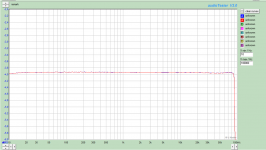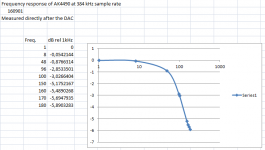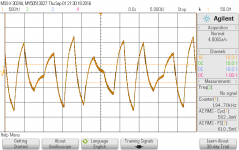Jens, maybe you have already addressed it before,and if so I apologize, but what is the target bandwidth of the generator and analyzer?
Jan
Jan
Initially it will run at a maximum sample rate of 192 kHz.
The bandwidth is around 90 kHz.
A higher bandwidth will require another ADC Board, with modified filter/driver. It will also require a modification of the XMOS firmware. The ADC will probably have to be a "non-audio" type to get a linear frequency response at 384 and 768 kHz sample rates.
The DAC may have to be changed as well if it should run at the same sample rate as the ADC. I have not seen specifications of the performance of the AK4490 at sample rates above 192 kHz. And I haven't checked myself.
Jens
The bandwidth is around 90 kHz.
A higher bandwidth will require another ADC Board, with modified filter/driver. It will also require a modification of the XMOS firmware. The ADC will probably have to be a "non-audio" type to get a linear frequency response at 384 and 768 kHz sample rates.
The DAC may have to be changed as well if it should run at the same sample rate as the ADC. I have not seen specifications of the performance of the AK4490 at sample rates above 192 kHz. And I haven't checked myself.
Jens
Hi Jens,
-Chris
Okay, that's intelligent. Thank you for answering that question.When the power is on, it will go to the range selected by the user. If an overvoltage comes in, it will switch off the direct path to the input amplifier, if the user has selected one of the low voltage settings (3V or below).
-Chris
Initially it will run at a maximum sample rate of 192 kHz.
The bandwidth is around 90 kHz.
A higher bandwidth will require another ADC Board, with modified filter/driver. It will also require a modification of the XMOS firmware. The ADC will probably have to be a "non-audio" type to get a linear frequency response at 384 and 768 kHz sample rates.
The DAC may have to be changed as well if it should run at the same sample rate as the ADC. I have not seen specifications of the performance of the AK4490 at sample rates above 192 kHz. And I haven't checked myself.
Jens
OK, thanks.
I may be able to test the AK4490 to 384. I don't have a way to go to 768 however.
If I can get the pieces talking I'll check its frequency response and distortion at the higher sample rates.
If I can get the pieces talking I'll check its frequency response and distortion at the higher sample rates.
Turns out I already did measure distortion at 384 KHz here http://www.diyaudio.com/forums/equi...g-digital-signal-generator-8.html#post4064708 I will test response when I patch it all back together.
Thanks, that would be great!
Here is a loop-back frequency response of the Audio Analyzer measured at 192 kHz. Some units have a slight deviation at the top, in the order of 0.1 dB, probably due to component tolerances in the filters.
Here is a loop-back frequency response of the Audio Analyzer measured at 192 kHz. Some units have a slight deviation at the top, in the order of 0.1 dB, probably due to component tolerances in the filters.
Attachments
AK4490: I managed to get the demo board into I2S mode and the filter into "fast' mode so it would have the most extended response. It turns out the Altor generator will clock up to 384KHz but the sine generator stops at 100 KHz in this firmware. In any case the DAC is down 4 dB at 100 KHz anyway so I'm not sure there is a lot useful above 100 KHz to be had.
Thanks for doing the test. It seems like the AK4490 has a frequency response similar to the ADC's from AKM, which is not a big surprise. E.g. the AK5397 rolls off quite a lot at sample rates above 192 kHz as shown in the data sheet.
You may be able to get them through Digikey. You can usually find more useful versions from China as DAC's. ADC's are a different story. The dev boards are not really the best execution. I had to really work on the AKD5394A to get the performance.
Today I got a new firmware for the XMOS USB Interface, which includes support for 384 kHz sample rate.
This gave me a possibility to measure the frequency response of the AK4490 DAC. I generated some files in Audacity with tones ranging from 1 kHz to 180 kHz. I also tried to enter 192 kHz, but the output contained all zeroes🙂
I measured the output directly from the DAC using an oscilloscope. The results are shown in the attached screen dump.
It doesn't drop quite as much as I expected, but it is far from being flat.
The ADC was removed from the unit during these measurements since the AK5394A does not support the 384 kHz sample rate.
I have also included an oscilloscope screen dump of the output at 160 kHz. There is definitely some work to do for the reconstruction filter😱
This gave me a possibility to measure the frequency response of the AK4490 DAC. I generated some files in Audacity with tones ranging from 1 kHz to 180 kHz. I also tried to enter 192 kHz, but the output contained all zeroes🙂
I measured the output directly from the DAC using an oscilloscope. The results are shown in the attached screen dump.
It doesn't drop quite as much as I expected, but it is far from being flat.
The ADC was removed from the unit during these measurements since the AK5394A does not support the 384 kHz sample rate.
I have also included an oscilloscope screen dump of the output at 160 kHz. There is definitely some work to do for the reconstruction filter😱
Attachments
Today I got a new firmware for the XMOS USB Interface, which includes support for 384 kHz sample rate.
A beef question: will your XMOS board (HW & Firmware & SW wise) able to run at 768kHz I/O?
Hp
I think it will but it is still TBD. It will probably require a change of MCLK frequency (due to the BCLK frequency needed) and a new firmware. The XMOS chip will probably be able to handle it.
Can it be used with common audio analyzer softwares availible like arta and such ?
Any updates on availability and cost ?
Any updates on availability and cost ?
Hi Jens,
Any reason why you don't start at the high range and seek down? It would seem to prevent excessive dissipation in the divider. Power off to open state for everything.
-Chris
Sounds like what Shibasoku does. If a range change is detected the auto ranger starts at maximum and then steps down.
It can be quite a shocking experience with 725D analyzer. The rate at which the relays are sequenced is tied into the response switches. In fast response one learns just how fast relays can be switched.
I thought it was a malfunction at first.
RM Marsh came up with an interesting suggestion in another thread. Which is to use a ranging IC designed for a multi-meter.
Hi David,
Interesting. I would be concerned about the extra noise and distortion those might have. They aren't optimized for low level audio / base band signals are they?
-Chris
Interesting. I would be concerned about the extra noise and distortion those might have. They aren't optimized for low level audio / base band signals are they?
-Chris
Hi David,
Interesting. I would be concerned about the extra noise and distortion those might have. They aren't optimized for low level audio / base band signals are they?
-Chris
I think Richard meant just for the detection and driving the relays.
Not as the switch element. It would require some modification of the switching thresholds.
Another suggestion was to use a led bar driver IC. But again it would require modifying the switching thresholds.
- Home
- Design & Build
- Equipment & Tools
- DIY Audio Analyzer with AK5397/AK5394A and AK4490


